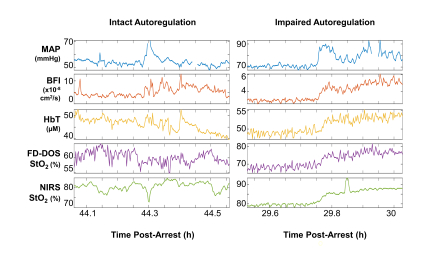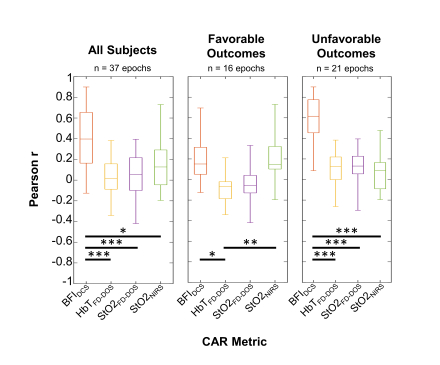Final ID: Su1005
Differences in optical metrics of cerebral autoregulation after pediatric cardiac arrest
Abstract Body: Introduction: Cerebral autoregulation (CAR) mechanisms, which maintain cerebral blood flow (CBF) over a range of mean arterial pressures (MAP), are impaired after cardiac arrest. Metrics of CAR impairment can be calculated from MAP and a CBF surrogate. Brain tissue oxygenation (StO2) derived from near-infrared spectroscopy (NIRS) has been used, but its approximation of CBF is limited. Advanced optical imaging can directly estimate CBF and StO2 with greater precision.
Aim: Compare CAR metrics derived from advanced optical modalities, including frequency-domain diffuse optical spectroscopy (FD-DOS) and diffuse correlation spectroscopy (DCS), with NIRS.
Hypothesis: CAR metrics derived from FD-DOS and DCS will not be significantly different from each other and NIRS.
Methods: We measured StO2 and total hemoglobin concentration (HbT) via FD-DOS, blood flow index (BFI) via DCS, and StO2 via NIRS for up to 8 h during the first 48 h after cardiac arrest. We identified 30-min epochs during which MAP changed more than 15% relative to the mean (Fig 1). Within each epoch, CAR was assessed using a moving-window Pearson correlation between MAP and each FD-DOS, DCS, and NIRS parameter. Pearson r values closer to 1 indicated impaired CAR and 0 to -1 indicated intact CAR. CAR metrics were compared by Kruskal-Wallis, and post-hoc pairwise comparisons with Bonferroni correction identified differences between metrics. Unfavorable outcomes were defined as hospital discharge PCPC score of 4-6.
Results: We identified 37 epochs of MAP change in 4 children (2 favorable, 2 unfavorable outcomes). We found significant differences between all 4 CAR metrics (p<0.001; Fig 2). In pairwise comparisons, StO2 from FD-DOS and NIRS did not differ (p>0.05). The DCS BFI metric exhibited more severe CAR impairment than NIRS StO2 across all subjects (p<0.05), with larger differences in unfavorable outcomes (0.62 [0.45,0.78] vs. 0.09 [-0.09,0.17], p<0.001) than in favorable outcomes (0.15 [0.05,0.31] vs. 0.15 [0.10,0.32], p>0.05).
Conclusion: CAR metrics derived from advanced optical modalities yielded variable results compared to NIRS in children after cardiac arrest. The DCS BFI metric demonstrated more severe CAR impairment than StO2 from either NIRS or FD-DOS, particularly in patients with unfavorable outcomes, suggesting that a more direct measure of CBF may be more sensitive to CAR impairment in post-arrest patients with deficiencies in cerebral oxygen delivery or utilization.
Aim: Compare CAR metrics derived from advanced optical modalities, including frequency-domain diffuse optical spectroscopy (FD-DOS) and diffuse correlation spectroscopy (DCS), with NIRS.
Hypothesis: CAR metrics derived from FD-DOS and DCS will not be significantly different from each other and NIRS.
Methods: We measured StO2 and total hemoglobin concentration (HbT) via FD-DOS, blood flow index (BFI) via DCS, and StO2 via NIRS for up to 8 h during the first 48 h after cardiac arrest. We identified 30-min epochs during which MAP changed more than 15% relative to the mean (Fig 1). Within each epoch, CAR was assessed using a moving-window Pearson correlation between MAP and each FD-DOS, DCS, and NIRS parameter. Pearson r values closer to 1 indicated impaired CAR and 0 to -1 indicated intact CAR. CAR metrics were compared by Kruskal-Wallis, and post-hoc pairwise comparisons with Bonferroni correction identified differences between metrics. Unfavorable outcomes were defined as hospital discharge PCPC score of 4-6.
Results: We identified 37 epochs of MAP change in 4 children (2 favorable, 2 unfavorable outcomes). We found significant differences between all 4 CAR metrics (p<0.001; Fig 2). In pairwise comparisons, StO2 from FD-DOS and NIRS did not differ (p>0.05). The DCS BFI metric exhibited more severe CAR impairment than NIRS StO2 across all subjects (p<0.05), with larger differences in unfavorable outcomes (0.62 [0.45,0.78] vs. 0.09 [-0.09,0.17], p<0.001) than in favorable outcomes (0.15 [0.05,0.31] vs. 0.15 [0.10,0.32], p>0.05).
Conclusion: CAR metrics derived from advanced optical modalities yielded variable results compared to NIRS in children after cardiac arrest. The DCS BFI metric demonstrated more severe CAR impairment than StO2 from either NIRS or FD-DOS, particularly in patients with unfavorable outcomes, suggesting that a more direct measure of CBF may be more sensitive to CAR impairment in post-arrest patients with deficiencies in cerebral oxygen delivery or utilization.
More abstracts on this topic:
A Recalled Experience of Death Among Cardiac Arrest Survivors Is Associated with Improved Psychological Outcomes
Goins Imani, Ingram Cambell, Wei Lijing, Gonzales Anelly, He Tun, Moore Sacha, Parnia Sam
A Patient and Family Advisory Council After Cardiac Arrest: A Patient-Centered Model of Community EngagementRiker Richard, Chessa Frank, Sawyer Douglas, Seder David B., Weatherbee Mary, Daley Alison, Searight Meghan, Lord Christine, Lessard Amanda, Feutz Catherine, May Teresa, Gagnon David


